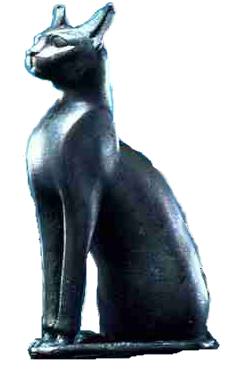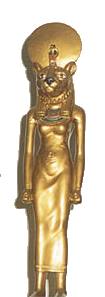Cats in Egypt

You are the Great Cat, the avenger of the gods, and the judge of what is said, and the chief of the great chiefs and the governor of the holy Circle; indeed, you are the Great Cat. (Egyptian inscription)
Was there a better time to be a cat than in Ancient Egypt, two or three thousand years ago? Were cats really considered gods?
One thing is certain, the evolution of the cat from a wild beast to the house cat of today probably began in ancient Egypt. Traces of cat bones have been found in human habitations long before (some of the earliest date to about 7000 BC) but it is uncertain whether these cats were pets or dinner. More interesting still are the remains of a cat found in Cyprus and dated to 5000 BC. Because cats were not native to the island, the cat must have been brought by ancient sailors, making this is the first ever evidence of a ship's cat.
But it was during the Middle Kingdom period of ancient Egypt (about three and a half thousand years ago) that cats and humans seem first to have seriously tried co-habiting. Almost certainly the first cats were African wild cats (Felis Lybica) which were attracted to human settlements by the presence of the vermin which helped themselves to human stores of food. Humans were happy for the help and so tolerated the cats. Thus the first relationship of cats and humans was that of symbiotic partners rather than owner and domestic animal. A silent third party in this relationship was the common rat - as this beast spread through Europe, so did the human adoption of cats into their households.
By the time Herodtus, the Greek historian, visited Egypt in the mid-fifth century BC, cats certainly had their furry paws well under the table. Herodotus reports that if a house were on fire, a chain of men would stand guard to make sure no cats were caught in the blaze, giving this job even greater priority than putting out the fire itself. Herodotus seemed to think that cats would want to rush into the burning buildings, which suggests a unfamiliarity with cats on the part of Herodotus personally, or perhaps of Greeks of his day in general. This may not have been surprising since there are indications in the ancient sources that the Egyptians were reluctant to allow cats to be taken out of the country.

While the Egyptians did not consider cats themselves as divine, they certainly took the death of a cat very seriously. Herodotus reports that if a cat died in a house, the householders would shave off their eyebrows in mourning, and the historian Diodorus Siculus confirms that this grief was still felt in the Egypt of 60 BC, when the death of a cat caused 'great lamentation' and '...after it has been treated with cedar oil and such spices as have the quality of imparting a pleasant odour and of preserving the body for a long time, they lay it away in a consecrated tomb.'
Over a thousand years of reverently burying cats meant that 19th century Egyptologists found archaeological sites that were virtually paved with mummified cat corpses. Around 80,000 were found outside the town of Beni Hasan alone, and at one time there was a plan to ship the mummies back to Europe to be ground up and used as fertilizer. This would have called down fervent curses from the spirits of the Egyptians who buried them, people who took their devotion to cats so seriously that (according to Diodorus) even accidentally killing a cat led to immediate lynching by a superstitious mob. In fact Diodorus claims to have seen just such an incident when a Roman accidentally ran over a cat, and could not be saved either by the pleas of the pharoah or the respect owed to mighty Rome.
Cats were closely identified with Bast, a goddess with the body of a woman and the head of a cat. Though there were other feline divinities, Bast could claim the most worshippers, and a temple in Bubastis which Herodotus claimed was 'not as large as those of other cities, and probably not as costly, yet no temple in all of Egypt was more pleasurable for the eye to look upon'. (How very cat-like!)
Bast was originally a totemic lioness-goddess of lower Egypt. When this area was absorbed into the Egyptian kingdom Bast the lioness protectress became Bast, the cat-headed, protector of the home. She was often depicted with kittens, and many Egyptian women sported amulets with this motif, perhaps with the number of children the woman wanted being shown by the number of kittens with the goddess. The temple itself was aswarm with cats - so many in fact that there is evidence that the priests were forced to keep the numbers down by selective culling - some of the mummies that have survived the vandalism of the past two hundred years show cats of several months to two years of age. Some researchers have even suggested that some cats were especially bred for sacrifice, or bred and killed so that their mummified bodies could be sold as relics to pilgrims.
The priveleged position of cats began to wane during the Roman occupation of Egypt, and declined yet further with the advent of Christianity, which respected cats less than many other religions. (It is said that the prophet Mohammed cut off a portion of his robe rather than disturb a cat sleeping on it, and the Norse goddess Freya - after whom Friday is named - rode a chariot drawn by cats.) Now, after centuries of being suspected of diabolical connections, cats are once again enjoying a golden age. There are an estimated 70 million cats in the USA alone, many of them enjoying lives of pampered luxury that their Egyption predecessors would certainly envy.

